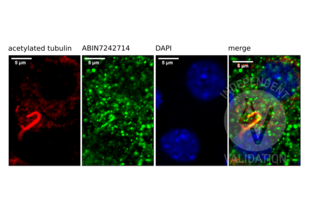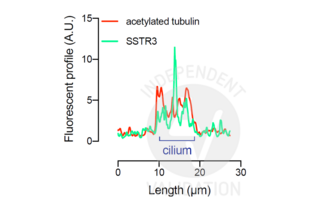SSTR3 antibody
-
- Target See all SSTR3 Antibodies
- SSTR3 (Somatostatin Receptor 3 (SSTR3))
-
Reactivity
- Human
-
Host
- Rabbit
-
Clonality
- Polyclonal
-
Conjugate
- This SSTR3 antibody is un-conjugated
-
Application
- Immunohistochemistry (IHC), ELISA
- Characteristics
- Polyclonal Antibody
- Purification
- Affinity purification
- Immunogen
- Synthetic peptide of human SSTR3
- Isotype
- IgG
-
-
- Application Notes
- IHC 1:50-1:200
- Restrictions
- For Research Use only
-
- by
- Idevall Lab, Department of Medical Cell Biology, Uppsala University
- No.
- #103937
- Date
- 06/18/2019
- Antigen
- SSTR3
- Lot Number
- DK1445
- Method validated
- Immunofluorescence
- Positive Control
Pancreatic beta cell line MIN6, stained for acetylated tubulin
- Negative Control
- Notes
ABIN7242714 specifically labels the targeted antigen in mouse insulinoma cells in IF. No signal was detected in sample negative control tissue and the secondary antibody only control.
- Primary Antibody
- ABIN7242714
- Secondary Antibody
- Full Protocol
- Grow MIN6 cells (gift from Prof. Yamamura) in DMEM (ThermoFisher, 41965039, lot 2071491) supplemented with FBS (ThermoFisher, 10500064, lot 08Q6291K) and Penicilin-Streptomycin (ThermoFisher, 15140122, lot 2051356), at 37 °C and 5% CO2 in 2 mL on glass coverslips.
- Starve cells for 48 h in serum free medium to promote ciliogenesis.
- Wash cells with 37 °C DPBS (ThermoFisher, 14190094, lot 2062255).
- Fix cells on coverslips in 4% PFA for 2 min at RT.
- Wash cells 3x for 2 min with PBS.
- Permeabilize cells in PBS containing 0.1% Triton-X for 2 min at RT.
- Block non-specific binding with PBS containing 1% serum for 1 h at RT.
- Incubate cells with primary
- rabbit anti-SSTR3 antibody (antibodies-online, ABIN7242714, lot DK1445) and
- mouse anti-actetylated tubulin (Sigma-Aldrich, T7451, lot 078M4842V) diluted 1:100 in 1% BSA PBS for 2 h at RT.
- Wash cells 3x for 2 min with PBS.
- Incubate cells with secondary
- goat anti-rabbit AF488-conjugated antibody (ThermoFisher, A11034, lot 2069632) and
- goat anti-mouse AF568-conjugated antibody (ThermoFisher, A11004, lot 927620) diluted 1:200 in 1% BSA PBS for 1 h at RT.
- Wash cells 2x for 2 min with PBS.
- Mount coverslips on glass slides in ProLong Gold antifade reagent with DAPI (ThermoFisher, P36935, lot 2086914).
- Image acquisition with Zeiss LSM780, 60x magnification.
- Experimental Notes
Our results are consistent with previous studies that have revealed the exclusive expression of SSTR3 in the cilia of mouse pancreatic beta-cells (Iwanaga et al. (2011)).
Validation #103937 (Immunofluorescence)![Successfully validated 'Independent Validation' Badge]()
![Successfully validated 'Independent Validation' Badge]() Validation ImagesFull Methods
Validation ImagesFull Methods -
- Format
- Liquid
- Concentration
- 0.4 mg/mL
- Buffer
- PBS with 0.05 % sodium azide and 50 % glycerol, PH7.4
- Preservative
- Sodium azide
- Precaution of Use
- This product contains Sodium azide: a POISONOUS AND HAZARDOUS SUBSTANCE which should be handled by trained staff only.
- Storage
- -20 °C
- Storage Comment
- Store at -20°C. Avoid freeze / thaw cycles.
-
- Target
- SSTR3 (Somatostatin Receptor 3 (SSTR3))
- Alternative Name
- SSTR3 (SSTR3 Products)
- Background
- Somatostatin acts at many sites to inhibit the release of many hormones and other secretory proteins. The biological effects of somatostatin are probably mediated by a family of G protein-coupled receptors that are expressed in a tissue-specific manner. SSTR3 is a member of the superfamily of receptors having seven transmembrane segments and is expressed in highest levels in brain and pancreatic islets. SSTR3 is functionally coupled to adenylyl cyclase.
- NCBI Accession
- NP_001042
- UniProt
- P32745
-



 (1 validation)
(1 validation)



